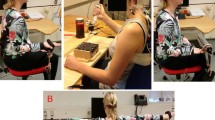Summary
Surface electromyographic recordings from the lateral and the cervical portions of the descending trapezius muscle and from the infraspinatus muscle were assessed for 12 female subjects during performance of a standardized repetitive work simulation task involving 1 h of continuous work and 1 h with introduced pause activities. Discomfort ratings and ratings of perceived exertion were also assessed. Work pace was determined according to MTM-110 (Methods-Time Measurement) as 2466 cycles for both working hours. Muscle fatigue with a decrease in the mean power frequency and an increase in root mean square amplitudes was found both during continuous work and during work with pause activities. The muscle fatigue was less pronounced when pause activities were introduced into the work. Five-minute fatigue patterns were lower during the second hour, indicating adaptation to the work task and work pace. The ratings of perceived exertion and discomfort were similar during work with and without pauses and were higher during the second hour of work. Both work pace and a varied muscle activity pattern are of importance for prevention of muscle fatigue.
Similar content being viewed by others
References
Aarås A, Westgaard RH (1987) Further studies of postural load and musculoskeletal injuries of workers at an electromechanical assembly plant. Appl Ergonomics 18:211–279
Basmajian JV, De Luca CJ (1985) Muscle fatigue and time-dependent parameters of the surface EMG signal. In: Basmajian JV, De Luca CJ (eds) Muscles alive: their function revealed by electromyography. Williams and Wilkins, Baltimore, pp 201–222
Bechtold SE, Janaro RE, Sumners DWL (1984) Maximation of labor productivity through optimal rest-break schedules. Management Science 30:1442–1458
Bhatia N, Murrell KFH (1969) An industrial experiment in organized rest pauses. Hum Factors 11:167–174
Bigland-Ritchie B, Woods JJ (1984) Changes in muscle contractile properties and neural control during human muscle fatigue. Muscle Nerve 7:691–699
Borg G (1970) Perceived exertion as an indicator of somatic stress. Scand J Rehabil Med 2:92–98
Byström SEG, Mathiassen SE, Fransson C (1991) Physiological effects of micropauses in isometric handgrip exercise. Eur J Appl Physiol 63:405–411
Christensen H (1986) Muscle activity and fatigue in the shoulder muscles during repetitive work. An electromyographic study. Eur J Appl Physiol 54:596–601
Colquhoun WP (1959) The effect of a short rest-pause on inspection efficiency. Ergonomics 3:376–372
Eilon S (1964) On a mechanistic approach to fatigue and rest periods. Int J Prod Res 3:327–332
Geissler HJ (1960) Zu einigen Untersuchungsergebnissen auf dem Gebiet der Ausgleichsgymnastik während der Arbeitszeit. Wiss DHFK 3:229–242
Gerdle B, Elert J, Henriksson-Larsén K (1989) Muscular fatigue during repeated isokinetic forward flexions in young females. Eur J Appl Physiol 58:666–673
Hagberg M, Sundelin G (1986) Discomfort and load on the upper trapezius muscle when operating a wordprocessor. Ergonomics 29:1637–1645
Henning RA, Sauter SL, Salvendry G, Krieg Jr EF (1989) Microbreak length, performance, and stress in a data entry task. Ergonomics 32:855–864
Herberts P, Kadefors R, Broman H (1980) Arm positioning in manual tasks. An electromyographic study of localized muscle fatigue. Ergonomics 23:655–665
Inman VT, Saunders JBCM, Abbott LC (1944) Observations on the function of the shoulder joint. J Bone Joint Surg 26:1–30
Itani T, Onishi N, Sakai K, Shindo H (1979) Occupational hazard of female film rolling workers and effects of improved working conditions. Arh Hig Rada Toksikol 30:1243–1251
Janaro RE, Bechtold SE (1985) A study of the reduction of fatigue impact on productivity through optimal rest break scheduling. Hum Factors 27:459–466
Jonsson B (1984) Muscular fatigue and endurance basic research and ergonomic aplications. In: Kumamoto M (ed) Neural and mechanical control of movement. Yamaguchi Shoten, Kyoto, pp 64–76
Kadefors R, Kaiser E, Petersén I (1968) Dynamic spectrum analysis of myopotential with special reference to muscle fatigue. Electromyography 8:39–74
Kilbom Å, Persson J (1987) Work technique and its consequences for musculoskeletal disorders. Ergonomics 30:273–279
Laporte W (1966) The influence of a gymnastic pause upon recovery following post office work. Ergonomics 9:501–506
Lindman R, Eriksson A, Thornell L-E (1991) Fiber type composition of the human female trapezius muscle: enzyme-histochemical characteristics. Am J Anat 190:385–392
Lindström L, Kadefors R, Petersén I (1977) An electromyographic index for localized muscle fatigue. J Appl Physiol: Respir Environ Exercise Physiol 43:750–754
Magnusson K (1972) The development of MTM-2, MTM V and MTM-3. J Methods-Time Measurement 17:11–23
Öberg T, Sandsjö L, Kadefors R (1990) Electromyogram mean power frequency in non-fatigued trapezius muscle. Eur J Appl Physiol 61:362–369
Öberg T, Sandsjö L, Kadefors R (1991) Variability of the EMG mean power frequency: a study on the trapezius muscle. J Electromyogr Kinesiol 1:237–243
Rohmert W, Luczak H (1973) Ergonomische Untersuchung von Teilzeit-Schichtsystemen und Pausen bei informatorischer Arbeit. Int Arch Arbeitsmed 31:171–191
Sjøgaard G, Kiens B, Jørgensen K, Saltin B (1986) Intramuscular pressure, EMG and blood flow during low-level prolonged static contraction in man. Acta Physiol Scand 128:475–484
Sundelin G, Hagberg M (1989) The effects of different pause types on neck and shoulder EMG activity during VDU work. Ergonomics 32:527–537
Taylor FW (1913) The principles of scientific management. Harper and Brother, New York London
Veiersted KB, Westgaard RH, Andersen P (1990) Pattern of muscle activity during stereotyped work and its relation to muscle pain. Int Arch Occup Environ 62:31–41
Author information
Authors and Affiliations
Rights and permissions
About this article
Cite this article
Sundelin, G. Patterns of electromyographic shoulder muscle fatigue during MTM-paced repetitive arm work with and without pauses. Int. Arch Occup Environ Heath 64, 485–493 (1993). https://doi.org/10.1007/BF00381096
Received:
Accepted:
Issue Date:
DOI: https://doi.org/10.1007/BF00381096




